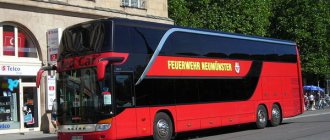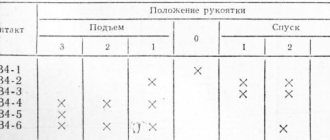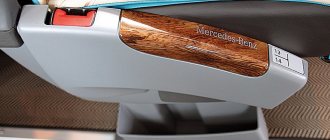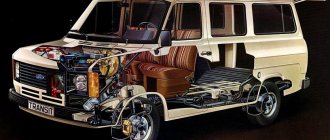Passenger Deluxe Suite
Alexander Trokhachev, photo by the author
The pinnacle of the TopClass 400, the descendant of the double-decker Setra S 328 DT, began to shine in all its colors in the fall of 2002. In 2003, the flagship of the company's passenger fleet was the honorary host at the Setra Grand Prix. Then the Germans got greedy and didn’t let anyone drive on the legendary Nürburgring. “Half a million euros is not a joke,” the burghers said solemnly. And this year I was specially invited to Germany, offering to conduct a test drive without restrictions in Stuttgart and its environs. Yes, it would be a sin to refuse such a gift!
There is demand!
While I waited 7 years for the opportunity to get behind the wheel of this luxury double-decker, I managed to try out the double-deck Scania, double-decker Neoplan and MAN. Meanwhile, the 500th anniversary Setra S 431 DT was sold in December 2007 to Voyages Demy Cars from Luxembourg. And where does so much money come from in this tiny country?! In Russia, gold and foreign exchange reserves are already being squandered, it’s even surprising why no one bought the latest generation “Setrovsky” double-decker: sales through the official representative office “EvoBus Russland” are zero. And “gray” dealers do not import such exotic goods due to the lack of consumer demand: there is no demand from businessmen, tour operators of transport companies... A very specific product and a risky means of investment.
A certain number of such airliners were expected on the secondary market in Russia after they were released from leasing from carriers in Germany, Luxembourg, France and other countries. But with the crisis, people became more tight-fisted. Prudent Europeans decided to drive this technology for another year or two until the situation settles down for the better, especially since EvoBus began to offer tools that allow operators to reduce operating costs.
By the way, take a closer look: there are quite a few double-deckers plying along the roads of Russia. And even though they were not bought brand new, the view from the second floor has already been appreciated in cities and towns.
Mobile mini-hotel
I had no doubt that the test drive would be brilliant. From the very beginning it was clear: the information provided would, as always, be minimal. For your reference, they gave out a very modest sheet with general and meager technical data of the 3-star Setra S 431 DT for comfortable short tours, while the test turned out to be a 4-star airliner for long trips. We had to fill in the gaps as the test progressed.
There is nothing to say about the fact that on board a 4-star “tourist” there is a refrigerator, a minibar, a kitchen and a toilet - this is clear from the level of equipment. But it is necessary to touch on the nuances. However, this does not prevent us from understanding the level of equipment of the mobile mini-hotel, which, in essence, is a German double decker.
The toilet cabin in this liner is located on the left side, behind the last row of seats on the first floor. A water tank with a capacity of 120 liters is provided for it. Nearby there is a tank of another 150 liters for water supply to the kitchen and toilet. An additional container of 80 liters of drinking water is located in the center of the bus, to the left of the second entrance.
With this amount of water and a supply of sausages and coffee, double deckers, for example, go from the capital’s Paveletsky station to Volgograd, Voronezh, Elista and Lipetsk.
The journey will be tireless also for the reason that there is a refrigerator on board with a usable volume of 93 liters. And such a gut is enough to simultaneously cool more than fifty bottles of mineral water and cans of beer. Some operators attach the trunk for food and replenishment of the refrigerator.
A centralized air conditioning system ensures the same microclimate on the first and second floors (5-star buses have an individual air conditioning system). The power of the air conditioner is quite enough to effectively cool a fairly large enclosed space. I rode as a passenger for several tens of kilometers, walking along both decks, and felt good everywhere, but only in the back row of seats did I feel a strong stream of cold air. After a long stay in the sun, my plans were not to catch a cold, so I had to master the ceiling sector of the air ducts. First, I changed the direction of the flow through the nozzle several times, and then completely closed this “wind tunnel”. He did the same at a nearby place, and the powerful wind blowing stopped.
Individual lighting lamps are installed in the ceiling block next to the ventilation louvres and the speaker. For an additional fee, instead of incandescent lamps, energy-saving LED technology lamps with cold light are installed. Next to them there is a button to call a guide or flight attendant, which, again, for an additional fee, will not be dull, but glowing. The symbols on the ceiling control units are simple and clear (there is even an ISO standard for this!).
There are two LCD monitors on the upper deck and one below. Broadcast to them is carried out from the on-board video player or from a satellite repeater.
For the wardrobe, the Setra S 431 DT has several cargo cells with a total volume of 8.4 m3 (their number may vary regardless of capacity). The most extensive are located in the stern, above the rear axles. But four more flat compartments with a useful volume of 0.8 m3 are equipped under the platform between the front and middle axles. As expected, for an additional fee you can equip a rest area for the shift driver. In this case, the auxiliary apartments will occupy a volume of 2.5 m3. On the 2-story model of the previous generation Setra S 328 DT, the owner of the vehicle could not afford such luxury even for money!
Setra S431 DT: Flagship to all flagships
For the first time in Russia. These words began the presentation of the Setra S431 DT tourist liner, held at the 6th Russian International Motor Show. Interest in German land frigates is always great, and here is a double-decker, and what a one!
The Setra division, part of the EvoBus GmbH holding (this is a trademark of the Karl Kassbohrer company), is not new to the creation of double-decker tourist liners. The history of his construction of flagship buses goes back to the 50s of the last century. From 1955 to 1958, the Golden Eagle (“Golden Eagle”) with an increased passenger compartment height was produced under the Setra brand for the US market. In 1967, the company's specialists created the panoramic Setra S150, in which the rear part of the cabin rose above the front. However, neither one nor the other was produced in large quantities. The situation changed only in the mid-70s, when in Europe the demand for passenger airliners with a large number of comfortable seats increased by leaps and bounds. While Moscow was preparing to host the XXII Olympics, new production facilities were being prepared in the city of Ulm (where Setra is based). A year later, everyone saw the first Setra double-deck model S228 DT. It was “doomed” to success primarily due to its successful design. The assessment was not long in coming: European journalists recognized the Setra S228 DT as the best double-decker in the world. Two more Olympics passed, and in December 1992, serial number 1000 left the Ulm gates. In the fall of 1993, it was replaced by the S328 DT. In the three-star classification, it had a design for 83 and 89 seats (including the driver’s and tour guide’s seats), and in the four-star classification, it had 82 and 78 seats. Both firstborns, two-story tall, had an overall length of 12 m and a width of 2.5 m. Over the two decades that have passed since the beginning era of Setra brand double-deckers, about 1,900 of these vehicles were produced. In Germany itself, Setra accounts for a third of the tourist bus market. Many Germans characterize the development of the company with the famous Olympic motto, which in relation to Setra sounds like this: longer, further, more comfortable. The reason for the interpretation is legitimate: the company’s products indeed meet these parameters. The overall length of the flagship airliner has increased to 13.89 m, and the width has increased to 2.55 m. The location of the two fuel tanks has been conceptually changed. Now their total volume is 640 liters instead of the previous 480 liters. They are located in the rear of the bus, can be refueled both on the right and on the left and provide the liner with a greater range without refueling. And the level of comfort generally deserves a separate story.
Behind the increase in the size of the flagship, first and foremost, lies engineering excellence. The S431 DT has 9 additional frames to increase the degree of body rigidity. This mobile hotel, costing over half a million euros, is driven by a 503-horsepower V-shaped Mercedes “eight” OM 502 LA, paired with an AS-Tronic automatic transmission manufactured by ZF. Other versions of the bus are equipped with a 435 hp engine. With. with a 6-speed manual transmission or a 476 hp engine. With. with "automatic". Of course, they all meet Euro 3 standards. The new flagship received EBS electronic brakes and BA braking assistant as standard. The IES integrated electronics system has improved the interaction of the engine, transmission and brakes through data exchange. The result is a shorter braking distance. The double-deck S431 DT is attractive to tour operators because it has 4 more seats than other buses of the same class. According to the new concept, the Setra flagship can be equipped with a passenger cabin of up to 64 seats on the upper deck and up to 25 on the lower deck. The benefit is obvious: the cost of one seat becomes less, and this is an important argument in the fight against competitors. Operating costs are reduced thanks to an increased service interval of up to 90 thousand kilometers or maintenance once a year. However, the average tourist does not care about this. But he will appreciate the personal amenities. Among them is a substantial trunk volume. It is increased by 1.5 m3 due to an additional compartment within the wheelbase and is 8.4 m3. The tailgate can be widened by 2 cm, to 58 cm, and the loading height can be reduced by 15 cm, to 129 cm.
In addition to this, the useful area for hand luggage in the cabin has been increased. The salon itself has become more spacious. The ceiling height on the first floor reached 1824 mm, and on the second - 1683 mm. The TopAir heating and air conditioning system, made with the latest technology, deserves special mention. For example, it contains half as much coolant as usual. The flagship with 80 seats (78+1+1), presented at Krasnaya Presnya, also had axial airflow and heated window sills, video and audio equipment, which passengers would hardly call an excess. Operators appreciated the presence of a navigation system, an Intander engine brake, as well as an FPS system, which replaced the usual electrics. Russian pros who dropped by the driver's workplace on occasion clicked their tongues in admiration regarding the ergonomics. They were particularly impressed by the range of seat adjustments, which slide back 8cm further than the previous model.
The thumbs-up clearly indicated their appreciation for the Litronic headlights, the cataphoresis anti-corrosion coating and, of course, on an emotional level, the recognizable exterior design called La Linea. The world premiere of the three-axle double-decker Setra S431 DT from the TopClass 400 family took place last fall in Hannover, Germany. Less than a year has passed since the car was shown in Russia. By bus standards, the interval is short. He says that the company believes in the prospects of our market. Who knows, maybe soon not only Europeans, but also Russians will be able to travel abroad in flagships like the Setra S431 DT. I don’t know about you, but personally I believe in it!
Gentlemen seated
The passenger seats are simple, elegant and comfortable. But the distance to the seat in front is shorter here than in business class, and the next seat is located very close, and therefore a person of my size will no longer be able to sit cross-legged. Of course, there is a function to shift the chair on the aisle, literally like a matchbox.
The height of the chair with an integrated headrest from the floor is a little more than a meter (1082 mm), the width of the backrest is 440 mm, the width of the seat cushion is 450 mm. For dense and well-fed people it will be cramped here, but people of average build will not even notice the discomfort. The height of the back of the chair is 708 mm, and this allows you not to keep your neck muscles tense - you can rest your head on a solid headrest. The length of the pillow, 483 mm, is optimally selected: it is enough to support the buttocks and choose a relaxing pose. I myself fidgeted around in the chair to choose different positions for resting and sleeping, and found several options when I felt comfortable. By the way, the height of the chair cushion above the floor level, in my opinion, is also optimal - 455 mm. With this value, the legs of a person of average height do not get tired. I can’t vouch for how people feel at basketball heights.
But the most important thing: when buying a ticket, you need to know which seats you will be drawn for! The fact is that the distance between the seats seems the same only at first glance, but this is far from the case (see diagram). Let me just remind you that for a 3-star bus the distance between the seats should be 680 mm, and for a 4-star bus it should be 740 mm.
Wonderful ladder
On board the double decker there are two staircases leading to the second floor: one spiral and one L-shaped with two flights. By the way, as in many cruise ships, the height of the steps is different, which, according to the observations of ergonomists, will not allow the passenger to stumble.
The two lower steps of the front spiral staircase have removable covers, under which there are cavities for storing tools and spare parts. These are not standard “boxes” for spare parts. Manufacturers classify them as "additional boxes". Wow, “boxes” – 115 liters! These are 6 buckets for bolts and nuts for all occasions! For comparison, remember: the on-board refrigerator has a compartment capacity of 93 liters!
The miracles don't end there. The same spiral staircase at the front of the cabin is equipped with auxiliary storage with a useful volume of 210 liters. Access to this “closet” is organized from the passage, and the opening itself is closed by an elegant door. Directly above it, on the vertical wall, there is a mesh pocket for newspapers and magazines.
The steps of the second staircase, located at the back right, are of different heights. This staircase does not have steps with triangular landings, making it easier to climb up and down. The hiding place here is located behind the top step of the first flight. The lid opens on a vertical wall. The steps of both stairs are equipped with lighting. In general, the movement of passengers up and down is thought out to the smallest detail - you can’t complain. The only caveat: tall people need to bend down on the second deck.
Specifications
| Technical characteristics of Setra S431DT | |
| Purpose | Tourist |
| Overall dimensions, mm | 13890x2550x4000 |
| Wheelbase, mm | 6700+1350 |
| Turning radius, m | 11,38 |
| Number of seats | 79-89 |
| Number of doors for passengers | 2 |
| Luggage compartment capacity, cubic meters | |
| Total weight, kg | |
| Engine | Mercedes-Benz OM502LA |
| Engine displacement, l | 15,93 |
| Engine power, hp | 435,476,503 |
| Fuel tank capacity, l. | 560 filling from 2 sides |
| Transmission | |






